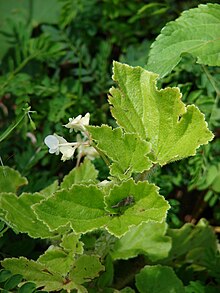Begoniaceae
The Begoniaceae are a family of flowering plants with about 1400-1500 species occurring in the subtropics and tropics of both the New World and Old World. All but one of the species are in the genus Begonia. The only other genus in the family, Hillebrandia, is endemic to the Hawaiian Islands and has only one species.
| Begoniaceae | |
|---|---|

| |
| Begonia hirtella | |
| Scientific classification | |
| Kingdom: | Plantae |
| Clade: | Tracheophytes |
| Clade: | Angiosperms |
| Clade: | Eudicots |
| Clade: | Rosids |
| Order: | Cucurbitales |
| Family: | Begoniaceae C.Agardh[1] |
| Genera | |

| |
| Range of the family Begoniaceae | |
Many varieties (or cultivars) of some species and hybrids of the genus Begonia are used as ornamental plants.
Description
changePlant and leaves
changeMost of the plants in this family are perennial herbaceous plants and very few are shrubs o subshrubs; they are from only a few centimetres to 3 metres tall. Their leaves and stems are succulents,[2] that is, leaves and stems are juicy and store water.
Stems are upright (vertical) and many species form rhizomes or tubers (fleshy, thickened underground stems). In some cases, the stems are very short and the leaves are in a group close to the soil.[2]
The leaves of most species are simple, undivided and with sides more or less unequal; in very few cases they are compound (divided). They are alternate or, when the stem is very short, they are all in a group.[2]
Flowers and fruits
changeBegoniaceae plants are mostly monoecious, so there are male and female flowers on the same plant; very few are dioecious, with only one kind of flower so the plants are either male or female. Flowers are grouped in inflorescences.[2]
The fruits are capsules (simple, dry fruits) and sometimes berries; they have many very small seeds.[2][3]
Chromosome number
changeThe chromosome number is variable, n=10-21 or more.[4]
Genera
changeThe family Begoniaceae was named in 1820 as Begoniae by the Bohemian scientists Friedrich Graf von Berchtold and Jan Svatopluk Presl in Prirozenosti Rostlin, 1:270, and then in 1824 as Begoniaceae by the Swedish botanist Carl Adolph Agardh, published in Aphorismi Botanici.[5]
There are two genera in this family:
- Begonia, with approximately 1400 species that are widely distributed in the tropics.[6]
- Hillebrandia, with one species that is endemic to the Hawaiian Islands and the only member of the Begoniaceae native to those islands.[7]
The New Guinean genus Symbegonia Warb. has recently been reduced to a section of Begonia.[6]
Where they grow
changeThe species of this family are found abundantly in all moist tropical countries, absent only from the Australian tropical forests.[8]
One species, B. grandis grows in the temperate zone, growing as far north as near Beijing (China).[6]
Uses
changeSome species, hybrids and cultivars of the genus Begonia are used worldwide as ornamental plants in parks, gardens, balconies and as houseplants because they have beautiful leaves and flowers.[4]
References
change- ↑ Angiosperm Phylogeny Group (2009). "An update of the Angiosperm Phylogeny Group classification for the orders and families of flowering plants: APG III". Botanical Journal of the Linnean Society. 161 (2): 105–121. doi:10.1111/j.1095-8339.2009.00996.x. Archived from the original on 2017-05-25.
- ↑ 2.0 2.1 2.2 2.3 2.4 Cuizhi Gu, Ching-I Peng & Nicholas J. Turland. "Begoniaceae in Flora of China". Retrieved 30 May 2013.
- ↑ Hyde, M.A., Wursten, B.T. & Ballings, P. "Begoniaceae - Begonia family". Flora of Zimbabwe. Retrieved 4 June 2013.
{{cite web}}: CS1 maint: multiple names: authors list (link) - ↑ 4.0 4.1 L. Watson and M.J. Dallwitz. "Begoniaceae C.A. Agardh". The familes of flowering plants. Archived from the original on 11 March 2013. Retrieved 3 June 2013.
- ↑ Agardh, C. A. "Aphorismi Botanici" (in Latin). p. 200. Retrieved 3 June 2013.
- ↑ 6.0 6.1 6.2 Laura Lowe Forrest, Mark Hughes & Peter M. Hollingsworth (2005). "A phylogeny of Begonia using nuclear ribosomal sequence data and non-molecular characters" (PDF). Systematic Botany. 30: 671–682. doi:10.1600/0363644054782297. S2CID 85909059. Archived from the original (PDF) on 2016-03-04. Retrieved 2013-06-04.
- ↑ Wendy L. Clement, Mark C. Tebbitt, Laura L. Forrest, Jaime E. Blair, Luc Brouillet, Torsten Eriksson & Susan M. Swensen (2004). "Phylogenetic position and biogeography of Hillebrandia sandwicensis (Begoniaceae): a rare Hawaiian relict". American Journal of Botany. 91 (6): 905–917. doi:10.3732/ajb.91.6.905. PMID 21653447.
{{cite journal}}: CS1 maint: multiple names: authors list (link) - ↑ Shahina Ghazanfar and Parveen Aziz. "Begoniaceae C. Agardh in Flora of Pakistan". Retrieved 3 June 2013.
Other websites
change- American Begonia Society
- Begonia - Gardenology.org Archived 2023-01-06 at the Wayback Machine
- A Phylogeny of Begonia Using Nuclear Ribosomal Sequence Data and Morphological Characters
- A recircumscription of Begonia based on nuclear ribosomal sequences Archived 2019-10-17 at the Wayback Machine
- Notes on the geography of South-East Asian Begonia and species diversity in montane forests Archived 2012-03-13 at the Wayback Machine
- Phylogenetic position and biogeography of Hillebrandia sandwicensis (Begoniaceae): a rare Hawaiian relict Archived 2010-07-31 at the Wayback Machine
- Phylogenetic Relationships of the Afro-Malagasy Members of the Large Genus Begonia Inferred from trnL Intron Sequences